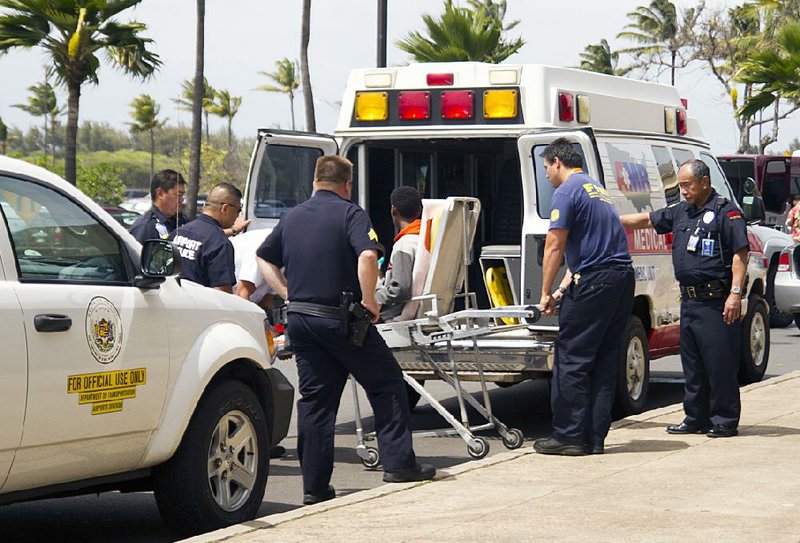A teenager who stowed away on a flight from San Jose, Calif., to Hawaii is raising questions about security at San Jose’s Mineta International Airport.
It’s unclear how long the boy was on the tarmac and why security officials didn’t detect he was there.
The 16-year-old had run away from home when he climbed the fence Sunday morning. Authorities say security video footage shows the teen crawling into the left rear wheel well of Hawaiian Airlines Flight 45.
“He was not planning on going to Hawaii,” said FBI Honolulu spokesman Tom Simon. “He just got on a plane.”
Authorities called it a “miracle” that the teen survived the 5½-hour flight. The wheel well of the Boeing 767 is not pressurized or heated, meaning the teen possibly endured extremely thin air and temperatures as low as 80 degrees below zero when it cruised at 38,000 feet.
“How he survived, I don’t know,” Simon said. The boy was unconscious for most of the flight, Simon added.
“I imagine he must have blacked out at about 10,000 feet,” he said. “The air is pretty thin up there.”
According to the Federal Aviation Administration, the plane’s steady climb to high altitudes may allow a person to drift into unconsciousness as oxygen becomes scarce. And as the heat dissipates from the wheel well, a stowaway can develop hypothermia, a condition that preserves the central nervous system. Both oxygen deprivation and hypothermia may resolve as the plane gradually descends for landing, the FAA said.
The plane landed at Maui’s Kahului Airport at 10:30 a.m. local time Sunday, but Simon said the teen did not regain consciousness for an hour. Once he woke up, he hopped down to the tarmac.
Hawaiian Airlines personnel noticed the teen on a ramp and notified security, airline spokesman Alison Croyle said in a statement released Sunday night.
“Our primary concern now is the well-being of the boy, who is exceptionally lucky to have survived,” the statement said.
Simon said the teen had run away from home. There was no indication that he posed a threat to the airline, and he has not been charged with a crime, officials said.
He cleared a medical checkup and was handed over to officials from the Hawaii Department of Human Services. Officials did not release his name because he is a minor.
Rosemary Barnes, a spokesman at the San Jose airport, said the FBI and Transportation Security Administration were investigating how the teen breached security and made it onto the plane but could provide no further comment.
Unlike checkpoint security inside the airport, which is overseen by the TSA, airport perimeters are guarded by local authorities, as well as federal law enforcement.
Brian Jenkins, an aviation security expert at Rand Corp., said security requirements for airport perimeters have steadily increased through the years to prevent unauthorized people or vehicles from getting near aircraft. Sunday’s intrusion raised concerns about access, he said, and whether the teenager’s actions could inspire someone else who “could do something truly dreadful.”
Jenkins said the breach would likely prompt a review of perimeter security not just in San Jose but at airports across the United States.
“Everyone will tighten up. I suspect everyone will be going up a notch just as a consequence of this,” he said.
U.S. Rep. Eric Swalwell, D-Calif., said on Twitter that he is concerned about the security issues. “I have long been concerned about security at our airport perimeters. #Stowaway teen demonstrates vulnerabilities that need to be addressed,” he wrote.
San Jose airport officials did not immediately return calls seeking comment.
The teen’s case is extreme, but it’s not the first time a stowaway has survived a flight in the wheel well of an aircraft.
In August, a teenage boy from Nigeria endured a 35-minute trip in the wheel well of a domestic flight that landed in Lagos. Officials said the trip’s short flight time and relatively low altitude helped him survive.
On another occasion, a stowaway managed to survive a flight from Havana to Madrid, according to the FAA.
The FAA said 105 stowaways have sneaked aboard 94 flights worldwide since 1947, and about 1 out of 4 survived. But agency studies say the actual numbers are probably higher, as some survivors may have escaped unnoticed, and bodies could fall into the ocean undetected.
Information for this article was contributed by Justin Pritchard, Daisy Nguyen, Martha Mendoza and Oskar Garcia of The Associated Press.
Front Section, Pages 4 on 04/22/2014

